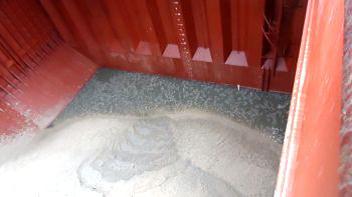Members are referred to the Association's previous advisory on the carriage of sand cargoes from Cambodia.
The Association would now like to advise further as follows.
There has been a recent marked increase in demand of this cargo in particular at Singapore, and reportedly more than 200 ships loaded this cargo in past two years at Cambodian ports.
In a recent matter the master of the vessel complained of the cargo being laden with excessive water / moisture. The Association appointed a surveyor to investigate the matter, but due to limited local resources the closest suitable Surveyor was located in Thailand and there was some noteworthy travel time involved given the location of some load locations in Cambodia.
In some locations the cargo is dredged with cranes from river and sea areas and then barged into lighters which are then sent to vessels for delivering cargo. The cargo is generally of very low value and the Association's concern was the safety of the vessel rather any shortage due to excessive water content.
The Shippers had declared the cargo as being Group C under the IMSBC Code, i.e. it was neither prone to liquefaction nor was it one which came with chemically hazardous properties. These declarations appear to be based on the specific schedule for SAND in the IMSBC Code. This schedule is intended for five specific named grades of industrial sand (foundry sand, potassium feldspar sand, quartz sand, silica sand and soda feldspar sand) and refers to a need to keep the cargo as dry as practicable. This indicates that the schedule is not intended for, and may not be appropriate for, the carriage of wet dredged sand deposits for use in land reclamation.
The schedule for SAND in the current version of the IMSBC Code remains unchanged from the 2004 BC Code. At the time, the regulatory approach was that sandy cargoes that may liquefy when wet were nevertheless classed as Group C if in shipping practice they are expected to be loaded very dry, without significant inherent moisture. In schedules that have been more recently revised, the IMO has taken the approach that sandy cargoes are Group A, i.e. liable to liquefy if shipped with excessive moisture, regardless of their typical moisture content at loading. With this approach, the IMO recognised the liquefaction risk of such cargoes when loaded wetter than anticipated, or becoming wetted during ocean carriage in the event of a casualty.
This has resulted in a regulatory inconsistency regarding the classification of dry sandy cargoes, with the schedule for SAND (Group C) contradicting the newly-introduced schedule for SAND, HEAVY MINERAL (Group A) in the 2013 IMSBC Code.
There are grounds for concern with the use of the SAND (Group C) schedule for wet dredged sand:
- Many natural river sands are known to be prone to liquefaction when saturated with water. River sand sediment deposits saturated with water are considered to be the prime risk for liquefaction in earthquake situations, e.g. in the 1995 Kobe and 2011 Christchurch earthquakes. Materials that can liquefy when saturated with water are classed as Group A in the IMSBC Code and should not be accepted for loading unless the moisture content is below the transportable moisture limit (TML), on the basis of pre-loading sampling and laboratory testing of the actual cargo to be loaded.
- There have been several casualties which may have involved carrying wet dredged sands in bulk. Liquefaction of iron sand, a type of wet beach sand high in iron oxide, has been implicated in the near-capsizing of one vessel in 2007 and the sinking of two vessels in 2012.
- Because of the risks involved when loading unidentified or mis-declared Group A cargo, Appendix 3 of the IMSBC Code states: "Many fine-particled cargoes if possessing a sufficiently high moisture content, are liable to flow. Thus any damp or wet cargo containing a proportion of fine particles should be tested for flow characteristics prior to loading."
The Association recommends that any damp or wet cargoes of sand should only be accepted for loading after they have been tested for flow characteristics, as specified in Appendix 3 of the IMSBC Code, and shown to be either not capable of liquefaction whatever the moisture content (Group C), or to have a moisture content below the TML when sampled and tested in accordance with the IMSBC Code (Group A).




Wet cargo in barge tendered for loading


Open top barges tendering cargo for loading
In case of further queries, Members are asked to contact the Association.
The Association is grateful to Martin Jonas of Brookes Bell for assisting the Association in preparing this update.